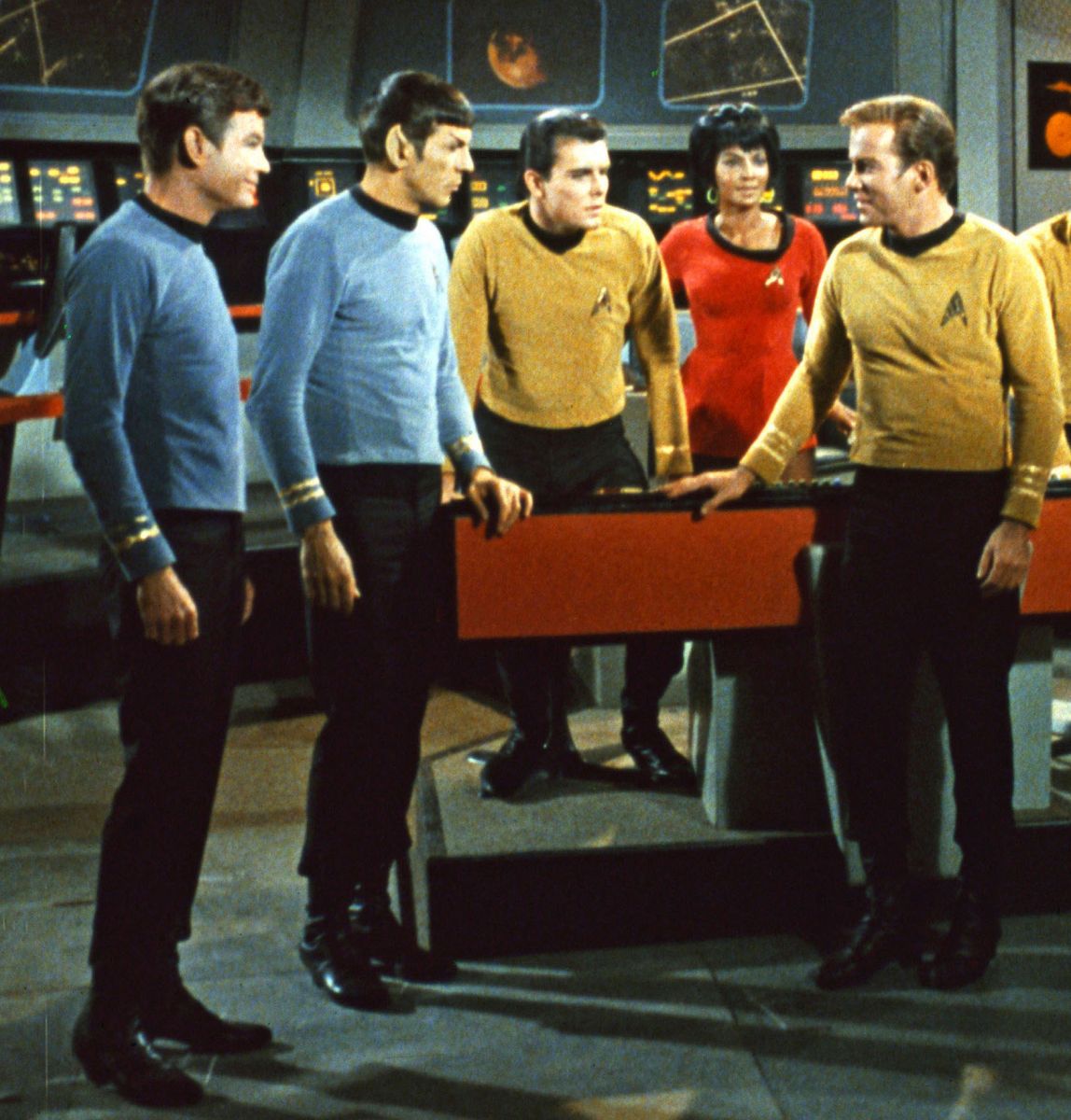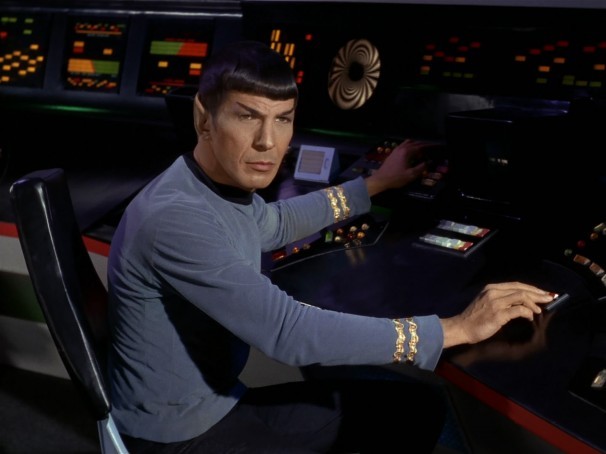“Someday,” producer Gene Roddenberry said many decades ago, “I’m going to make a science-fiction series and put pointed ears on that guy.”
The series was “Star Trek,” and the guy was Leonard Nimoy, who died Feb. 27 at 83. A tall, taut-faced actor, he had been laboring in obscurity for 15 years before Roddenberry hired him in 1966 to play the half-human, half-alien space explorer Spock.
Those pointy ears — along with the upswept eyebrows and “five-point” Vidal Sassoon bob — brought Mr. Nimoy enduring stardom in an entertainment and merchandising empire equaled perhaps only by the James Bond, “Star Wars” and “Harry Potter” franchises.
“Star Trek,” a drama about the adventures of the starship Enterprise as it explored “the final frontier” of space, was not a critical or popular hit during its initial run on NBC from 1966 to 1969.
In syndication, however, it became a phenomenon.

DeForest Kelley, left, Leonard Nimoy, second left, Nichelle Nichols, second right and William Shatner, right, appear in a scene from the TV series "Star Trek." (Anonymous/AP)
[Leonard Nimoy’s final public words: ‘Live long and prosper’]
Communities of fans known as “Trekkies” burst forth in the 1970s, creating richly imagined fantasy worlds that were based on the show and that were played out at large-scale conventions. Filmmaker George Lucas said “Star Trek” helped pave the way for his “Star Wars” movies. The success of “Star Wars,” in turn, helped spur the “Star Trek” film series.
As a television program, “Star Trek” proved groundbreaking in many ways. It served up allegorical tales about violence, greed, jealousy, prejudice, peace and love — the roiling social issues of the 1960s — in the guise of intergalactic adventure.
It did so, said television scholar Robert Thompson, “at a time when American television completely shied away from any kind of relevance or social controversy, except in the news.”
Its 23rd-century starship crew was a utopian federation of men and women, blacks and whites, Americans, Russians and Asians — and Spock, who was born on the planet Vulcan in a civilization that has mastered control of its feelings. (The Vulcan aphorism “live long and prosper” became a catchphrase.) He becomes the science officer and first mate aboard the Enterprise and was, science fiction writer Isaac Asimov once observed, a “creature of pure reason and no emotion.”
[President Obama: ‘I loved Spock’]
Spock was the ultimate outsider — a trait Mr. Nimoy said he understood. He was Jewish and had grown up in an Irish section of Boston. Going to movies as a child during the Depression, he was drawn to actors who specialized in bringing pathos to the grotesque — especially Boris Karloff in “Frankenstein” (1931) and Charles Laughton in “The Hunchback of Notre Dame” (1939).
By most accounts, Mr. Nimoy portrayed the most popular character of the “Star Trek” cast. While some critics thought that Mr. Nimoy’s acting was dour or wooden, fans might have argued that these were precisely the characteristics of the emotion-suppressing, logic-obsessed Spock.
In one episode called “The Naked Time,” a virus infects the spaceship and causes the crew’s “hidden selves” to emerge — revealing previously unknown dimensions of Spock’s nature. At one point, the chaos overtakes him, and he breaks down and cries.
“It solidified everything,” Mr. Nimoy told the New York Times in 1968. “I knew that we were not playing a man with no emotions, but a man who had great pride, who had learned to control his emotions and who would deny that he knew what emotions were. In a way, he was more human than anyone else on the ship.”
He added: “In spite of being an outcast, being mixed up, looking different, he maintains his point of view. He can’t be bullied or put on. He’s freaky with dignity. There are very few characters who have that kind of pride, cool and ability to lay it out and walk away. Humphrey Bogart played most of them.”
[William Shatner and George Takei mourn Leonard Nimoy’s death]
Leonard Simon Nimoy was born in Boston on March 26, 1931, to parents who had been peasants in what is now Ukraine. His father became a barber and urged his sons — Leonard and an older brother, Melvin — toward stable careers.
The boys grew up in a Yiddish-speaking household and attended Orthodox Jewish services, which became an unexpected influence on Mr. Nimoy’s role as Spock. His “Vulcan salute” — made by parting the middle and ring fingers of each hand — was based on a hand gesture he noticed while attending a synagogue as an 8-year-old.
“I didn’t know what it meant,” he once said, “but I knew it looked like something magical.”
Mr. Nimoy developed an early interest in acting, and he recalled that his parents were “grief-stricken” when he abandoned a scholarship at Boston College to seek a career in Hollywood.
In 1952, he won the title role, a boxer with a disfigured face, in the low-budget film “Kid Monk Baroni.” Mr. Nimoy mistakenly thought the part would launch his career. “It played about three days as a second bill somewhere in Hollywood and then died,” he told the Times. “Nothing happened and, in 1953, I went into the Army.”
After his discharge, he mostly played heavies on TV shows such as “Dragnet,” “Sea Hunt” and “Wagon Train” before his breakthrough in 1964 while acting on the adventure series “The Lieutenant.” Roddenberry was a producer of the show and soon hired him for “Star Trek.”
“For the first time, I had a job that lasted longer than two weeks and a dressing room with my name painted on the door and not chalked on,” Mr. Nimoy later told the Times.
Mr. Nimoy struggled with his “Star Trek” legacy. His first memoir, published in 1975, was called “I Am Not Spock.” It was followed 20 years later by “I Am Spock,” in which he said he had come to peace with the show that defined him in the public imagination.
He spoke openly about personal problems that developed during the making of the show. He became a heavy drinker, he said, to escape the pressures of sudden fame.
Mr. Nimoy described an intense “sibling rivalry” with William Shatner, who starred as the heroic Capt. James T. Kirk. Mr. Nimoy was nominated three times for the Emmy for best supporting actor but felt he deserved recognition for what was essentially a leading role. Meanwhile, Shatner received no nominations.
[Reaction from Leonard Nimoy’s fans — famous and not — pours in]
Mr. Nimoy, who took an earnest approach to his art, was often the butt of Shatner’s on-set pranks. On one occasion, Mr. Nimoy recalled, Shatner asked him to repeatedly retake an emotional scene in which the Vulcan cries out, “Pain! Pain!”
As Mr. Nimoy increased his volume and intensity, Shatner finally quipped to the crew, “Can someone get this guy an aspirin?”
Mr. Nimoy didn’t talk to Shatner for weeks.
They later reconciled. Mr. Nimoy said he stopped drinking in the late 1980s and that he helped Shatner through his marriage to an alcoholic and comforted him after the woman, Nerine Kidd, drowned in a swimming pool.
The original run of “Star Trek” was canceled because of dwindling ratings, and Mr. Nimoy’s strong identity as Spock made it hard for him to transcend the role. On the CBS series “Mission: Impossible” from 1969 to 1971, he played a master of disguise named Paris. From 1976 to 1982, he hosted the syndicated documentary series “In Search Of . . .,” which explored phenomena such as the Loch Ness monster and the Bermuda Triangle.
Mr. Nimoy wrote and performed in a one-man stage show about Theo van Gogh and his troubled but brilliant painter brother, Vincent.
[Leonard Nimoy’s struggle with being Spock]
He had supporting roles onscreen, but he was reluctant to reprise Spock for the first “Star Trek” movie in 1979. Mr. Nimoy felt he was owed royalties from the sale of toys, posters and other memorabilia bearing Spock’s image.
To persuade Mr. Nimoy to appear in “Star Trek II: The Wrath of Khan” (1982), Paramount studios offered him a plum role in its television production “A Woman Called Golda” about Israeli prime minister Golda Meir.
Mr. Nimoy was cast as Morris Meyerson, Meir’s husband, opposite Ingrid Bergman in the title role, and earned an Emmy nomination for his supporting role. The only consolation in losing, he said, was that it was to Laurence Olivier in the limited series “Brideshead Revisited.”
Spock had been killed saving the Enterprise crew in the second “Star Trek” movie but, to the relief of many enthusiasts, the character was revived in future movie installments that Mr. Nimoy also directed: “Star Trek III: The Search for Spock” (1984) and “Star Trek IV: The Voyage Home” (1986).
He later directed the hit comedy “3 Men and a Baby” (1987), starring Tom Selleck, Ted Danson and Steve Guttenberg as bachelors who care for an infant left on their doorstep. To less enthusiastic reviews, he directed Diane Keaton in “The Good Mother” (1988), based on the Sue Miller novel about a divorced mother whose newfound sexual passions threaten to consume her life.
Around the same time, Mr. Nimoy left his wife of 33 years, Sandra Zober, and they divorced. In 1989, he married actress Susan Bay. Besides his wife, survivors include two children from his first marriage, Adam and Julie; a stepson; a brother; six grandchildren; and a great-grandchild.
His son confirmed the death to the Associated Press. Mr. Nimoy had announced in 2014 that he had chronic obstructive pulmonary disease.
[PHOTOS: The man behind Starship Enterprise’s Vulcan]
Mr. Nimoy parlayed his “Star Trek” fame into a singing career in the late 1960s and 1970s, cutting albums such as “Leonard Nimoy Presents Mr. Spock’s Music From Outer Space.” He also published books of poetry and photography and championed progressive causes, including civil rights and Cesar Chavez’s efforts on behalf of immigrant farm workers.
The film or television offers that rolled in during his later life tended to be in the realm of science fiction. He was the voice of Sentinel Prime in the 2011 film “Transformers: Dark of the Moon,” and he participated in nearly all “Star Trek” film and TV incarnations.
He spoke to the writer Digby Diehl in 1968 about the strange effect Spock and his foam rubber ears had on women in particular. “I tell you frankly, I’ve never had more female attention on a set before,” he said. “And get this: They all wanted to touch the ears.”


